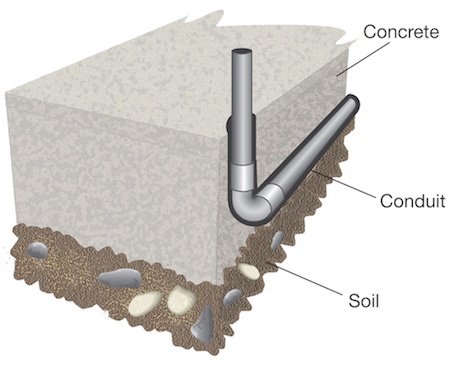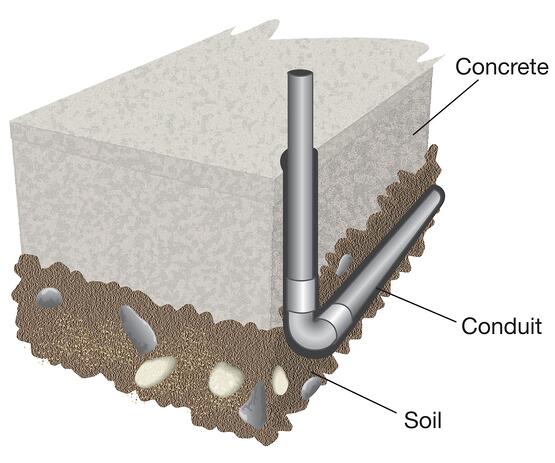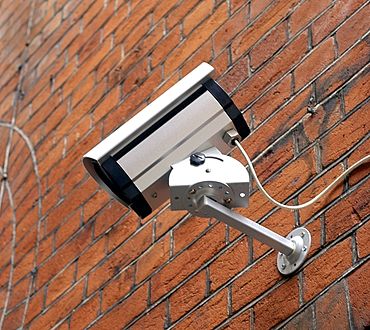Where OSP Cable Should Be Used
With outdoor ratings, OSP cable stands out from traditional indoor-rated copper or fiber cable for its ability to maintain performance despite harsh environmental conditions. It’s designed to withstand flooding, moisture and high and low temperatures, and resists abrasion and tearing, allowing you to extend your network outside, reaching across a large campus.
There are some common applications that frequently call for OSP cable – we’ll cover them here.
Conduit in Concrete Slab
Many new facilities being built today are a good example of conduit in concrete slab applications. In several of these projects, you’ll notice the conduit (plastic PVC or metal EMT) sticking up out of the concrete slab. The conduit often used in these applications is designed to run wires and cabling from a centralized location to many specific locations or endpoints. But, oftentimes, inside this conduit, you’ll find indoor-rated cable – a typical Category 6A cable, for example.
  |
| Conduit in Concrete Slab |
This situation represents three common mistakes made in applications where listed OSP cabling – cabling certified by UL – is better suited:
- Believing that the conduit is actually in an indoor application because it’s under the roof (when, in fact, the conduit extends beyond the building envelope – below the slab)
- The project team assumes that normal, indoor-rated cabling will perform well in outdoor applications as long as it’s protected
- The project team assumes that conduit is enough of a protector for indoor-rated cable
As any contractor or building owner will tell you, structures move and crack as they age and settle. Eventually, as the ground and concrete shift, conduit can be damaged. If the conduit cracks, water can infiltrate the conduit. If the cables inside that conduit are indoor rated, we’ve got bad news: They’re not designed to handle any moisture – so the cables won’t be able to maintain performance. The end result? Network downtime, damaged cables and the need to rip up and replace cabling infrastructure and conduit.
Differential temperatures can also cause damage to indoor-rated cables installed in conduit. When ground temperatures are cold, but above-ground temperatures are warmer, a high-pressure environment is created where air can be sucked in. Typically, air that is warmer has a higher moisture content. When this warm, moist air meets the colder temperatures below the concrete, condensation occurs, creating moisture. The moisture can collect on the inside of the conduit; if the cables inside that conduit are indoor rated, damage to the cable will occur – even if the conduit itself isn’t damaged.
Let’s consider a scenario where the conduit rises from the slab at the lowest point of the building. What if this lowest point is in the basement, and flooding occurs from excessive rain, a burst pipe or a toilet overflow? What if the flooding was high enough that it flowed into the top of the conduit? As the rain subsides, or the plumbing failure is fixed, the floodwater would be removed from the floor of the basement through a pumping system or wet-vac, but not from the conduit. Water would remain in the conduit. If the cables inside that conduit are indoor rated, they will be damaged over time.
But how will you ever know if there’s a break, crack or water in the conduit in the first place? During construction, it’s buried and hidden – once it’s placed underground, you’ll likely never see it again. One way to protect an indoor-rated cable in a conduit is to seal and pressurize the conduit. With a sensor to monitor the PSI rating, you can be notified of decreases and have time to investigate a potential problem early on; however, a pressurized system isn’t practical or cost effective for a typical enterprise. Most people won’t realize that the underground conduit has water and is damaging the indoor-rated cabling within until it’s too late – and network performance problems are obvious.
 |
| Conduit In-Grade Below Concrete Slab |
Conduit In-Grade Below Concrete Slab
Conduit in-grade below the concrete slab poses a similar challenge. Once contractors lay the conduit, rocks are placed on top, and the slab is placed on top of that.
Especially in geographic regions where rain is rare, or temperatures are fairly mild, many people take chances and run indoor-rated cable in conduit in these situations. But heavy rains do occur, even in locations that don’t often experience rain. Even flooding due to manmade disasters, such as plumbing mishaps, can cause water ingress into the conduit and expose the indoor-rated cable to outdoor elements that it isn’t designed to handle.
Exterior Camera Installation
The use of IP surveillance cameras is becoming more widespread, especially due to the ease of deployment when using Power over Ethernet (PoE).
Installing a camera on the exterior of a building and directly connecting it to the enterprise network is possible with an OSP cable that resists sunlight and wind exposure, and is able to handle colder temperatures. A CMX outdoor-rated OSP cabling has a cold impact listing to -20 degrees C and the ability to enter the building through the wall and continue to the centralized equipment room or consolidation point.
 |
| Security Camera with OSP Cabling |
The applications mentioned above are just a few examples of situations where OSP cable is being used today, helping networks extend to the outdoors. Want to learn more about OSP cable? Stay tuned to this blog – in a few weeks, we’ll talk about the standards behind OSP cable, as well as what to look for when searching for one. Subscribe to our blog updates so you don’t miss it!
To learn more about Belden’s OSP cable solutions, which defend against failure, watch this short video.
